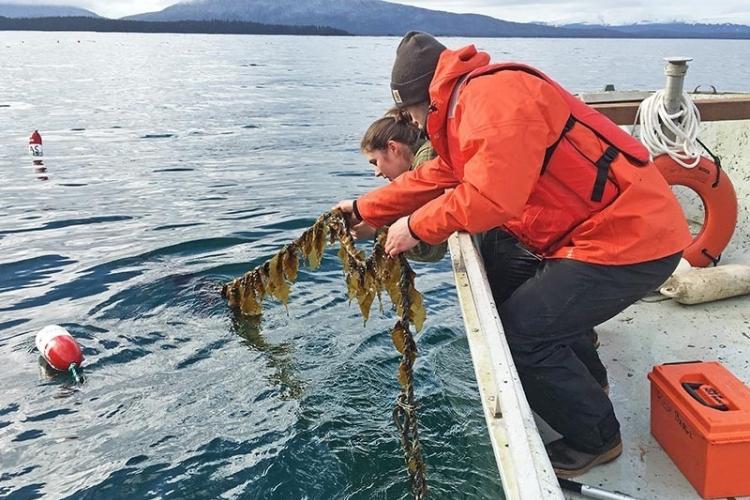U.S. seaweed farming has taken off in recent years, with dozens of farms in waters in New England, the Pacific Northwest, and Alaska and more in production. Farmers grow various types of seaweed—including dulse, bull kelp, ribbon kelp, and sugar kelp—that are used in sushi, salsas, sauces, salads, seasonings, and other food products.
Farmed seaweed is also an ingredient in cosmetics, animal feed, and fertilizer. Seaweed farms absorb nutrients and carbon dioxide to grow. The farms can help improve water quality and buffer the effects of ocean acidification in surrounding areas.
Seaweed as a Crop
For shellfish and finfish farmers, commercial fishermen, and first-time farmers, seaweed offers an opportunity to diversify a farming operation or start a new business. Seaweeds use the entire water column. This means farmers can grow seaweed using a process known as vertical, or 3D, farming—and reap large harvests from a small area. Most seaweeds grow on longlines suspended around 4–8 feet below the surface throughout the winter. Their blades will reach 10 feet or more before they are harvested in the spring.
Watch video on 3D ocean farming
Seaweed farming is the fastest-growing aquaculture sector. For example, farmers in Alaska produced more than 112,000 pounds of sugar, ribbon, and bull kelp in 2019. That’s a 200 percent increase over the state’s first commercial harvest in 2017. The largest kelp farm in North America is located off southeastern Alaska.
But the industry is still in a developmental stage. NOAA and our partners are investigating the siting requirements, designs, infrastructure, and best management practices. This work will help lead to more efficient permitting and allow seaweed farming to expand while also being economically and environmentally sustainable.
Training builds on growing popularity of kelp farming
NOAA Sea Grant’s National Seaweed Hub supports industry development
Environmental Benefits of Seaweed Crop Farms
Seaweeds are incredibly efficient at sucking up carbon dioxide and using it to grow. Eelgrass, mangroves, and salt marshes are already known for their ability to store carbon. But seaweeds pull more of the greenhouse gas from the water than all three combined based on biomass. That means seaweed farms can help to combat local impacts of ocean acidification.
Seaweeds also gobble up nitrogen and phosphorus. In large quantities, these nutrients cause algal blooms that deplete the ocean of oxygen when they decompose. Excess nitrogen and phosphorus from stormwater runoff and point-sources are behind the dead zones that form in the Gulf of America and Chesapeake Bay. Seaweed farms can help lower nutrient levels in nearby waters.
Seaweed Restoration Aquaculture
Kelp forests are a valuable coastal habitat in temperate areas throughout the world. In Puget Sound, bull kelp has declined extensively. NOAA is working with local partners to use restoration aquaculture approaches to regenerate these large, fast-growing kelps. The seaweeds create forage and refuge habitat for commercially important fish and diversity of marine life.
Seaweeds also act as a sponge soaking up what’s in the water. These marine plants could potentially be cultivated to reduce heavy metals and other coastal pollutants. Unlike in commercial seaweed farming, the seaweeds grown for this reason would never be eaten. Instead, communities and other stakeholders could establish seaweed farms in polluted areas with the sole aim of improving the health of coastal ecosystems.




